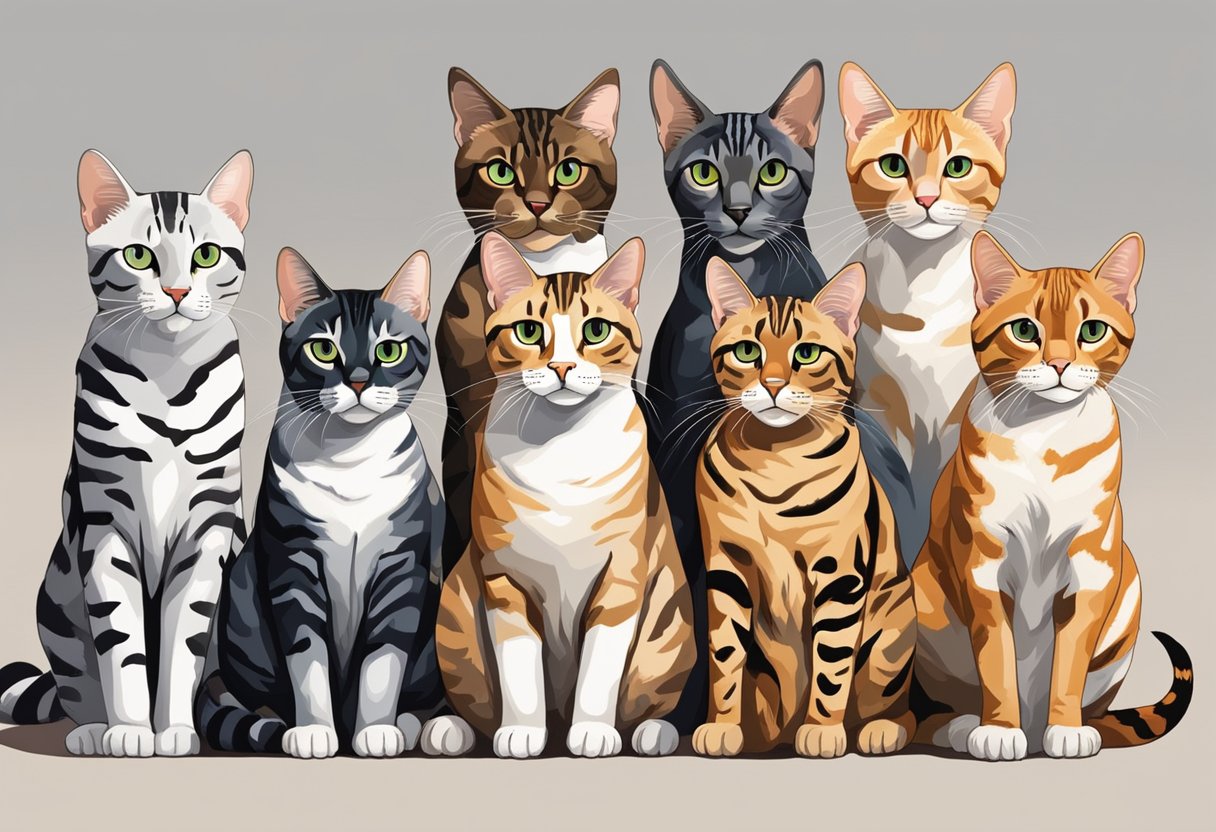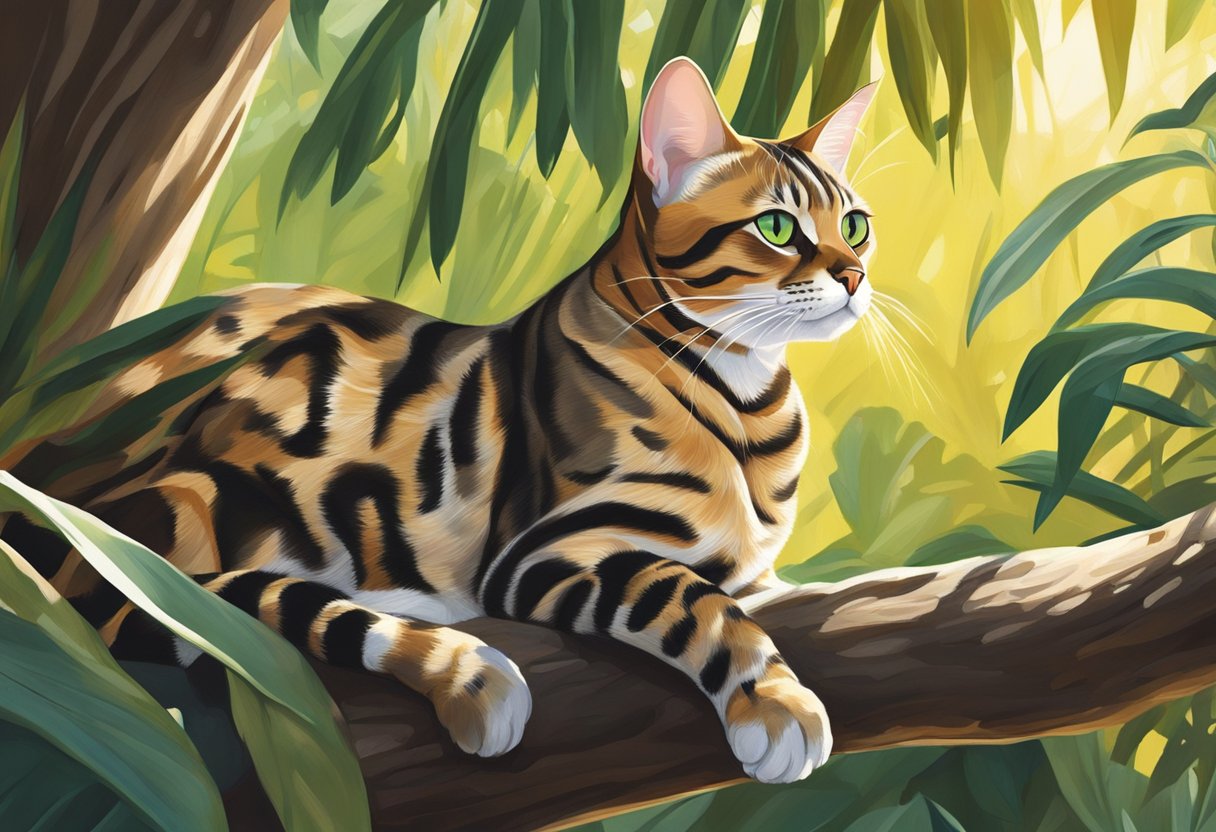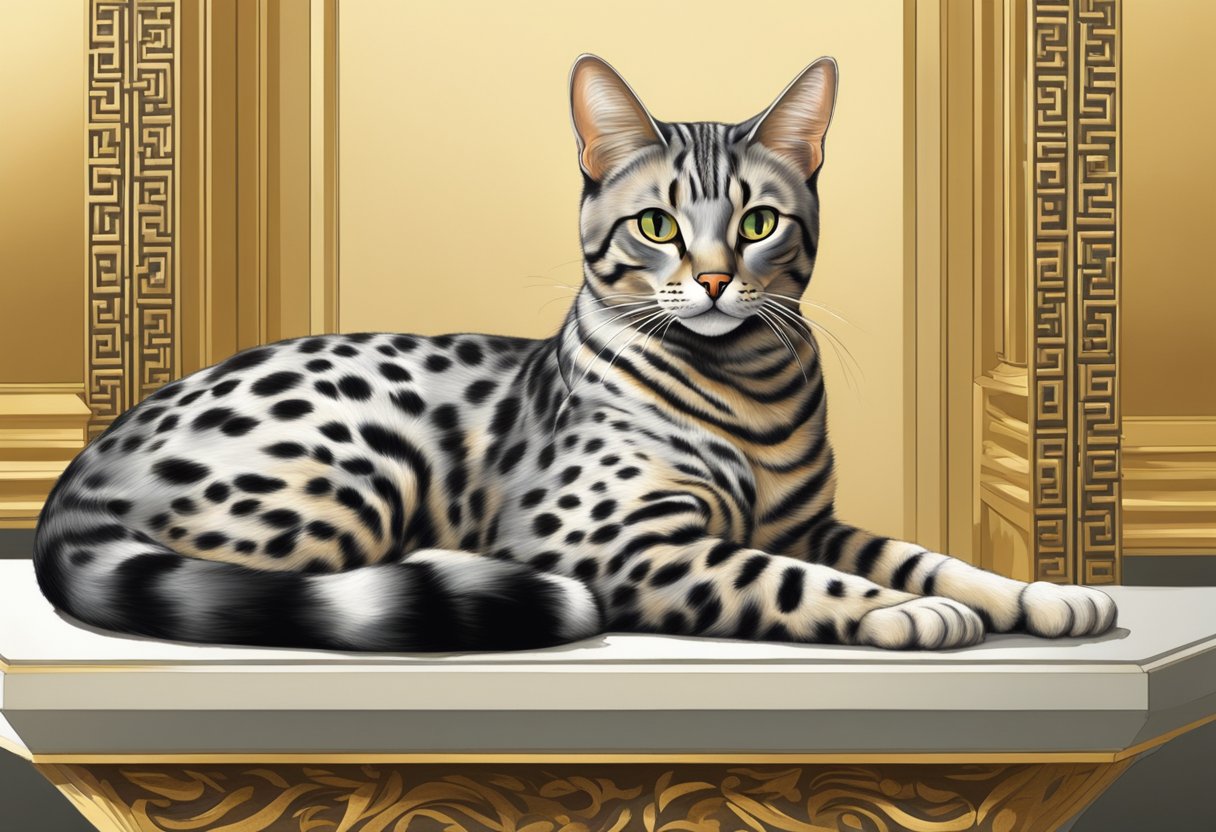Bengal cats captivate enthusiasts with their wild, exotic look and playful temperament. Originating from the crossbreeding of domestic cats with the Asian leopard cat, Bengals boast distinctive spotted coats that mirror their wild ancestors. For cat lovers who are drawn to this breed’s striking appearance and spirited nature, there are several other breeds that share similar aesthetic and behavioral traits.

Among the cat breeds that resemble Bengals, some stand out for their spotted or marbled coats, while others are cherished for their similar energy levels and intelligence. These breeds offer a range of personalities and appearances, from the sleek and agile Ocicat to the affectionate and sociable Savannah. Each of these breeds has unique characteristics, but they all provide a similar sense of enchantment that Bengal cat owners know and love.
For potential pet owners looking to bring a touch of the wild into their homes, exploring cat breeds similar to Bengals can be an exciting journey. Whether one is seeking a feline companion that is interactive, one with a striking coat, or a blend of both, there are breeds that suit a variety of preferences and lifestyles. These cats are not just pets; they become an integral part of the family, bringing joy with their unique charm and dynamic presence.
Understanding Bengal Cats

Bengal cats are a domestic breed that has been developed to resemble exotic wild cats. Characteristics of the Bengal cat include:
- Appearance: They exhibit a striking coat that features large spots, rosettes, and marbled patterns that resemble that of a leopard. The coat’s base color can vary from golden, rust, brown, and orange, to sand, buff, or ivory. Bengals have a sleek, muscular build and are medium to large cats.
- Temperament: Bengals are known for their playful, energetic, and affectionate nature. They are highly intelligent and often enjoy interactive toys and games. Socialization from an early age can contribute to their adaptability and friendly disposition towards people and other pets.
Health: Bengals are generally healthy, but can be prone to certain genetic conditions such as hypertrophic cardiomyopathy (HCM) and progressive retinal atrophy (PRA). It’s important for potential owners to seek reputable breeders who screen for these issues.
Activity Level: This breed has a high energy level and requires ample mental and physical stimulation. They are often fond of climbing and may enjoy access to high places like cat trees.
Care: Bengal cats have short coats that require minimal grooming. However, regular brushing can help minimize shedding and support coat health. Due to their intelligence and activeness, Bengals benefit from interactive play and enrichment activities.
Providing a stimulating environment and engaging regularly with a Bengal cat is crucial for their wellbeing. Owners should be prepared for a sociable and high-spirited companion.
Egyptian Mau – The Spotted Ancestor

The Egyptian Mau holds a distinguished place as a naturally spotted breed that possesses a rich historical lineage and a striking appearance.
Origins and History
The Egyptian Mau’s lineage dates back to ancient Egypt, making it one of the oldest domesticated cat breeds. They are depicted in the artwork of early Egyptian civilizations, often alongside pharaohs and nobles. These cats are not just admired for their beauty; they were also revered for their hunting prowess and were associated with Egyptian deities.
Physical Attributes
Egyptian Maus are medium-sized, muscular cats known for their distinctive spotted coats. They possess a unique combination of physical traits:
- Coat: Short-haired with vivid spots that can be silver, bronze, or smoke-colored.
- Eyes: Gooseberry green, set in a slightly worried expression.
- Legs: Hind legs are longer than their front ones, contributing to their notable speed and agility.
Temperament and Behavior
Egyptian Maus are known for their loyal and affectionate nature. They tend to form strong bonds with their owners and have been characterized by the following behaviors:
- Social: Friendly towards family members and can live well with other pets.
- Playfulness: Active and playful, they enjoy interactive toys and games.
Ocicat – The Wild Look Without Wild DNA
The Ocicat possesses the allure of a wild cat while being entirely domesticated in its genetics, a perfect blend for enthusiasts who admire the feral aesthetic but desire a friendly companion.
Breed Background
The Ocicat breed emerged accidentally from a crossbreed of Siamese and Abyssinian cats, intending to create a Siamese with Abyssinian points. First appearing in the 1960s, this breed was later refined with the addition of American Shorthair to establish its distinctive silver color and solid physique.
Appearance Traits
Patterns and Colors: The Ocicat boasts spots reminiscent of wild cats, usually contrasted against a lighter background and distributed evenly across the body. Common color variations include tawny, chocolate, and silver.
| Coat | Description |
|---|---|
| Length | Short |
| Texture | Smooth, satiny |
| Patterns | Spotted |
| Color Variants | Tawny, Chocolate, Cinnamon, Blue, Fawn, Silver |
Physical Build: With a well-muscled torso, strong legs, and a sleek athletic build, the Ocicat carries a striking similarity to its wild ancestors. They typically weigh between 6 to 15 pounds, with males being larger.
Personality Features
The breed is known for its sociable nature, being quite extroverted, they thrive in human company. People-oriented and affectionate, Ocicats are also intelligent and easily trained. They often exhibit a playful and curious demeanor, which makes them interactive and entertaining pets. They are prone to vocalization, often chirping and meowing to communicate with their owners.
Savannah – The Exotic Blend
The Savannah cat is a captivating hybrid that combines the wild African serval with a domestic feline, creating a unique and striking breed that is reminiscent of the Bengal in its exotic appearance and daring persona.
Breed Genesis
The Savannah breed originated from the crossbreeding of the wild African serval and domestic cats. This blend first occurred in the 1980s, resulting in a cat with a remarkable appearance and size. Through careful breeding, they have become more accessible to cat enthusiasts looking for an exotic pet.
Distinctive Characteristics
- Coat: The Savannah’s coat is typically short and has a spotted pattern, resembling that of its wild ancestor, the serval.
- Size: One of the largest domestic cat breeds, they can weigh between 12 to 25 pounds, with males generally being larger.
- Ears: They boast large, tall ears set right on top of the head, adding to their wild look.
- Legs: Their legs are long and slender, contributing to their impressive height and agile movements.
Behavioral Traits
Savannah cats possess a blend of behaviors from their wild and domestic ancestries:
- Activity Level: They are highly active and playful cats that require sufficient exercise and mental stimulation.
- Intelligence: Savannahs are intelligent and curious, often learning how to open doors or retrieve objects much like a dog.
- Social Nature: While they may display caution around strangers, they are generally loyal to their owners and can form strong bonds with their human families.
Abyssinian – The Tropical Appearances
The Abyssinian cat boasts a resemblance to the wild coats of a tropical jungle, with a striking historical heritage and an engaging social demeanor.
Historical Lineage
The Abyssinian cat is believed to originate from Southeast Asia and the coast of the Indian Ocean. Genetic evidence points to a lineage that may have begun in ancient Egypt, but their actual origin remains a mystery.
Visual Hallmarks
Abyssinians are renowned for their ticked coats, which give an iridescent and wild look similar to the Bengal’s pattern. Their fur has alternating light and dark bands on each hair shaft, commonly in ruddy, sorrel, blue, and fawn colors. Their almond-shaped eyes can be gold or green, enhancing their exotic appearance.
Social and Activity Level
Abyssinians are often highly social and enjoy being around their human companions. They possess a high energy level, requiring ample playtime. Their athleticism is on par with Bengals, making them adept at climbing and jumping.
Toyger – The Mini Tiger
The Toyger is a breed designed to resemble a miniature tiger with distinctive stripes and an athletic build.
Development and Breeding
The Toyger breed was envisioned by Judy Sugden in the late 1980s, aiming to create a cat with a striking striped coat reminiscent of a tiger. Selective breeding involved crossing Bengal cats with striped domestic shorthairs to enhance the tiger-like aesthetic. This process meticulously refined the patterns and body type over the years.
Physical Appearance
Toygers are medium-sized cats with a robust and muscular physique. Their coat is characterized by bold, black stripes and a warm orange background. The stripes are vertical and evenly distributed, a signature trait purposefully developed to mirror a wild tiger’s pattern. Their appearance also features circular head markings and high cheekbones, adding to the resemblance.
Interactive Nature
Toygers are active and friendly, often seeking interaction with people. They are known for their playful demeanor and enjoy various forms of mental and physical stimulation. These cats are highly adaptable and can thrive in a family environment, making them a delightful addition to a household seeking an engaged feline companion.
Cheetoh – A Newer Crossbreed
The Cheetoh cat is a distinct breed that combines the best of the Bengal and Ocicat breeds, known for its striking looks and amiable nature.
Creation and Recognition
The Cheetoh came into being through selective breeding between a Bengal cat and an Ocicat. This intentional crossbreeding aimed to produce a cat with specific characteristics: the wild appearance of the Bengal and the amiable disposition of the Ocicat. Though not yet recognized by major feline organizations like the CFA, the Cheetoh has gained recognition from smaller institutions such as the United Feline Organization (UFO), reflecting its increasing popularity among cat enthusiasts.
Unique Appearance
Cheetoh cats are impressive visually, boasting a well-muscled and sturdy frame. They display a short and smooth coat that features a rich array of spots and rosettes, closely resembling a wildcat’s appearance. Their bold markings come in various colors, including but not limited to brown spotted, lynx spotted, and silver.
| Color Varieties |
|---|
| Brown Spotted |
| Lynx Spotted |
| Silver |
Companion Qualities
As companions, Cheetoh cats are known for their affectionate and playful demeanor. They adapt well to family environments and are typically good with children and other pets. Their intelligence and curiosity make them interactive pets, often engaging in play and seeking the attention of their human family members.
- Affectionate: Enjoys closeness with family members.
- Playful: Loves interactive games and toys.
- Intelligent: Quickly learns and responds to training.
Serengeti – The Graceful Mix
The Serengeti cat is a crossbreed that captures the wild essence of the Bengal with a more domesticated temperament.
Breeding and History
The Serengeti cat breed was developed by biologist Karen Sausman in 1994 by crossing Bengal and Oriental Shorthair cats. The aim was to create a cat resembling the African Serval without direct use of wild blood.
Notable Features
Appearance: Serengetis are medium-sized cats with long legs, large ears, and spotted coats, giving them an exotic appearance akin to their Bengal relatives.
Coat and Color: They sport a short, silky coat that comes in shades like golden, smoke, black, and spotted tabby.
Living with Serengetis
Personality: These cats are known for their energetic, playful nature, and they possess a friendly disposition that makes them suitable for family life.
Activity Level: Serengetis are active and require ample playtime, responding well to interactive toys that stimulate their keen hunting instincts.
Health and Care for Bengal-like Breeds
Bengal-like cat breeds share similar health and maintenance needs, with a focus on managing inherited conditions and maintaining their unique coats.
Common Health Concerns
Bengal-like breeds are generally hardy but they can inherit specific health conditions. Hypertrophic cardiomyopathy (HCM) is a common heart disease in these breeds, characterized by the thickening of the heart’s muscular walls. Regular veterinary screenings can help detect such issues early. Progressive retinal atrophy, which can lead to blindness, may also affect these breeds. A genetic test can determine if cats carry the PRA gene before they are bred.
Grooming and Care
These cats’ coats are short to medium in length and require regular grooming to maintain their lustrous appearance. A weekly brushing session is typically enough to remove loose hair and distribute skin oils. For breeds resembling the Bengal’s exotic pattern, such as the Toyger or Savannah, care should be taken to keep their skin healthy, as dermatological issues can arise from poor grooming.
Dietary Needs
A balanced diet is critical for maintaining the health and energy levels of Bengal-like breeds. High-quality cat food rich in protein supports their muscular build and active nature. These breeds often thrive on a combination of dry kibble and wet food, providing a mix of textures and hydration. Consultation with a vet can ensure their dietary regimen supports any special health considerations.
Finding a Bengal-like Cat Breed
When seeking a cat breed similar to Bengals, prospective owners should explore options through adoption or reputable breeders, understand the care requirements, and acknowledge the associated costs and commitment.
Adoption and Breeders
Adoption:
- Check local animal shelters and rescue organizations.
- Search for breed-specific rescues that specialize in Bengal and Bengal-like breeds.
Breeders:
- Look for breeders that are registered with cat fancier associations.
- Research breeders’ reputation through reviews and cat owner forums.
Considerations for Owning
Personality Traits:
- Stamina and playfulness similar to Bengals.
- High energy levels, requiring ample playtime.
Space and Environment:
- Need for an enriched environment with vertical spaces for climbing.
- Access to interactive toys to stimulate their natural hunting instincts.
Cost and Commitment
Initial Costs:
- Adoption fees or purchase price could range from moderate to high.
- Possible higher fees for specific breed traits or pedigree.
Ongoing Commitment:
- Monthly expenses for food, litter, and grooming.
- Potential veterinary costs for routine check-ups and vaccinations.




